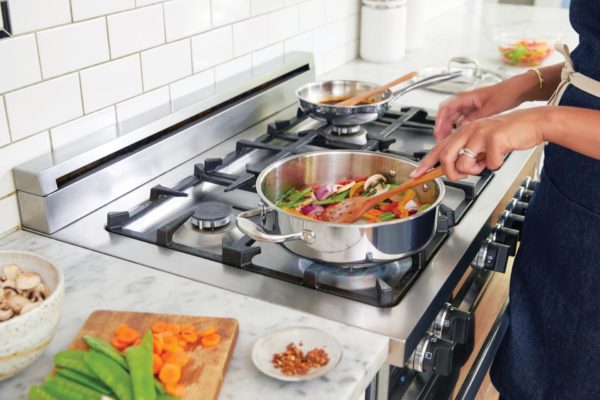10 Tips for Building or Enhancing Flavor
Creating flavorful food is an ultimate cooking goal, yet it can sometimes feel daunting. Often, when I am talking with cooking class participants, they are hesitant when it comes to discussing about how to build flavor. It’s fun to watch their eyes light up when they learn that they are already using many techniques, they’re just not aware of it. Confidence boost!
By applying some basic principles, you can build flavor in any recipe you may be preparing, and “voila!”, mission accomplished. See how many of these tips you already use (you might be surprised, too!), and which ones you can add to your cooking process repertoire.
1. START WITH GOOD QUALITY INGREDIENTS
This may sound very basic, but truly, using good quality ingredients is the foundation of a flavorful dish. Poor quality ingredients simply will not possess the flavor horsepower you’ll desire. This does not mean constantly splurging on expensive items or that “expensive” equals good quality. Many value ingredients fit the bill. Be selective, learn about what’s in season, and seek out high-quality, low- or less processed brands of pantry, frozen and refrigerated goods.
2. USE A FLAVORFUL BASE
Creating a flavorful base of chopped aromatics adds character to dishes. A few common flavor bases by type of cuisine include:
- French and Italian – onions, carrots, and celery
- Cajun “Holy Trinity” – onions, celery, green pepper
- Asian – garlic, scallions/onions/shallots, ginger
- Indian – onions, garlic, chilis, ginger
- Middle Eastern – onions/scallions, garlic, tomatoes, dried fruit
- Latin – onions, garlic, tomatoes, bell pepper
3. REMOVE WATER CONTENT TO CONCENTRATE FLAVORS
Many foods naturally contain water which helps maintain freshness but can dampen the flavor of a dish during cooking if not removed.
- “Sweat” (over low heat), sauté (over medium heat), or roast (using high heat) vegetables to remove water content.
- Reduce sauces, stocks, wine, juices or balsamic vinegar by simmering over low or medium heat to deepen flavors.
4. USE FRESH SEASONINGS
Since herbs and spices play a strong supporting role in cooking, it’s important to pay attention to their freshness.
- Shop for fresh and dried herbs and spices at quality grocers or specialty food shops.
- Buy small amounts so they do not go bad or lose their flavor.
- Smell and taste them to see if they are flavorful.
- Store them properly.
- To coax the most flavor out of herbs, add them to liquids in a recipe. To maximize the flavor of spices, add them to the fats in a recipe.
5. ADD ACIDS
Acids bring out the brightness of food, heighten flavors and reduce the need for additional salt. Try adding small amounts of one or two of these during cooking, near the end, or just before serving.
- Citrus juice or zest
- Vinegar
- Cider
- Wine and other alcohol
6. USE FATS TO YOUR ADVANTAGE
Fats add a creaminess that enhances the flavor and texture of foods and assists other ingredients in releasing their goodness. Choose healthier, less processed fats made from natural ingredients such as avocados, olive or avocado oil, nut, seed or infused oils, regular or Greek yogurt, plant-based milk, sour cream, real mayonnaise, or cottage cheese without added sugar or artificial additives.
7. HIGHLIGHT NATURAL FLAVORS
Use simple cooking processes to bring out the natural flavor of ingredients and elevate their flavor profiles.
- Lightly brown, caramelize, or roast vegetables
- Sear animal or plant proteins
- Toast spices, nuts, and seeds
8. SCRAPE UP THOSE “BROWNED BITS”
Those browned bits on the bottom of the pan after searing or sautéing foods are flavor gems! To loosen and incorporate them into the recipe, add a small amount of wine or other alcohol, diced tomatoes, tomato sauce or paste, cider, juice, water, or broth. Allow to simmer gently for 30 – 60 seconds, then use a wooden spoon to scrape up the bits. They will melt into the other recipe ingredients and provide a savory richness.
9. ADD FLAVOR-BOOSTING CONDIMENTS
Condiments are great flavor boosters and can be added to soups, stews, chilis, sauces, casseroles, pasta dishes, vegetables, and proteins. Add them during the cooking process or as a flavorful garnish when serving. Look for low- or no sugar, low sodium varieties.
- mustard
- horseradish
- wasabi
- miso
- soy sauce
- fish sauce
- chipotle peppers
- hot sauce
- tapenades
- salsa
- pesto
- chutney
- red bell pepper spread
10. ADD SALT
Salt is an essential ingredient for flavoring food. It provides a boost to a dish that tastes flat and also lessens bitterness. Adding salt earlier in the cooking process allows time for it to infuse into the ingredients and distribute evenly. Salt added later in the process provides a stronger flavor, so less is needed. If a low salt diet is recommended, use the other flavor-building tips recommended above (#1 – #9) and add a small amount of salt later in the cooking process or afterward, if at all.
SUBSCRIBE
For more cooking tips and recipes, subscribe to “Fresh Take”, my free monthly newsletter.
Photo: Unsplash/Brandless
© 2020 Love + Craft Kitchen, LLC, All Rights Reserve


Recent Comments